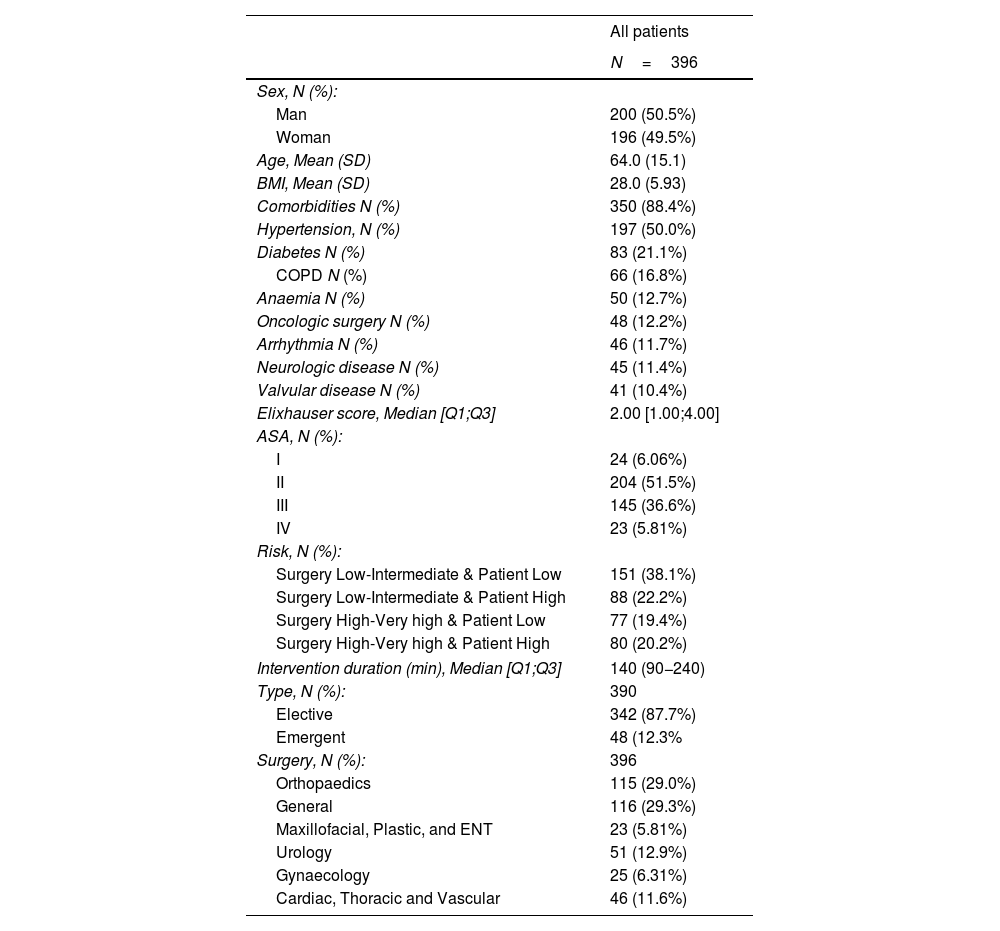Intraoperative fluid administration is a ubiquitous intervention in surgical patients. But inadequate fluid administration may lead to poor postoperative outcomes. Fluid challenges (FCs), in or outside the so-called goal-directed fluid therapy, allows testing the cardiovascular system and the need for further fluid administration. Our primary aim was to evaluate how anesthesiologists conduct FCs in the operating room in terms of type, volume, variables used to trigger a FC and to compare the proportion of patients receiving further fluid administration based on the response to the FC.
MethodsThis was a planned substudy of an observational study conducted in 131 centres in Spain in patients undergoing surgery.
ResultsA total of 396 patients were enrolled and analysed in the study. The median [interquartile range] amount of fluid given during a FC was 250ml (200–400). The main indication for FC was a decrease in systolic arterial pressure in 246 cases (62.2%). The second was a decrease in mean arterial pressure (54.4%). Cardiac output was used in 30 patients (7.58%), while stroke volume variation in 29 of 385 cases (7.32%). The response to the initial FC did not have an impact when prescribing further fluid administration.
ConclusionsThe current indication and evaluation of FC in surgical patients is highly variable. Prediction of fluid responsiveness is not routinely used, and inappropriate variables are frequently evaluated for assessing the hemodynamic response to FC, which may result in deleterious effects.
La administración intraoperatoria de fluidos es una intervención ubicua en los pacientes quirúrgicos. Pero la administración inadecuada de fluidos puede llevar a malos resultados postoperatorios. La prueba de volumen (PV), dentro o fuera de la denominada fluidoterapia guiada por objetivos, permite probar el sistema cardiovascular y la necesidad de administración adicional de fluidos. Nuestro objetivo primario fue evaluar el modo en el que el anestesiólogo realiza la PV en el quirófano en términos de tipo, volumen, variables utilizadas para impulsar la PV, y comparar la proporción de pacientes que recibieron administración adicional de fluidos basada en la respuesta a la PV.
MétodosSe trata de un subestudio planificado de un estudio observacional realizado en 131 centros en España, en pacientes sometidos a cirugía.
ResultadosEn el estudio se incluyó y analizó a 396 pacientes. La cantidad media [rango intercuartílico] de fluidos administrados durante la PV fue de 250ml (200–400). La principal indicación de la PV fue el descenso de la presión arterial sistólica en 246 casos (62,2%). La segunda indicación fue el descenso de la presión arterial media (54,4%). Se utilizó el gasto cardiaco en 30 pacientes (7,58%), y la variación del volumen sistólico en 29 de entre 385 casos (7,32%). La respuesta a la PV inicial no tuvo impacto a la hora de prescribir administración adicional de fluidos.
ConclusionesLa indicación y evaluación actual de la PV en los pacientes quirúrgicos es altamente variable. La predicción de la receptividad a los fluidos no se utiliza rutinariamente, evaluándose a menudo las variables no adecuadas para valorar la respuesta hemodinámica a la PV, pudiendo causar efectos perjudiciales.











